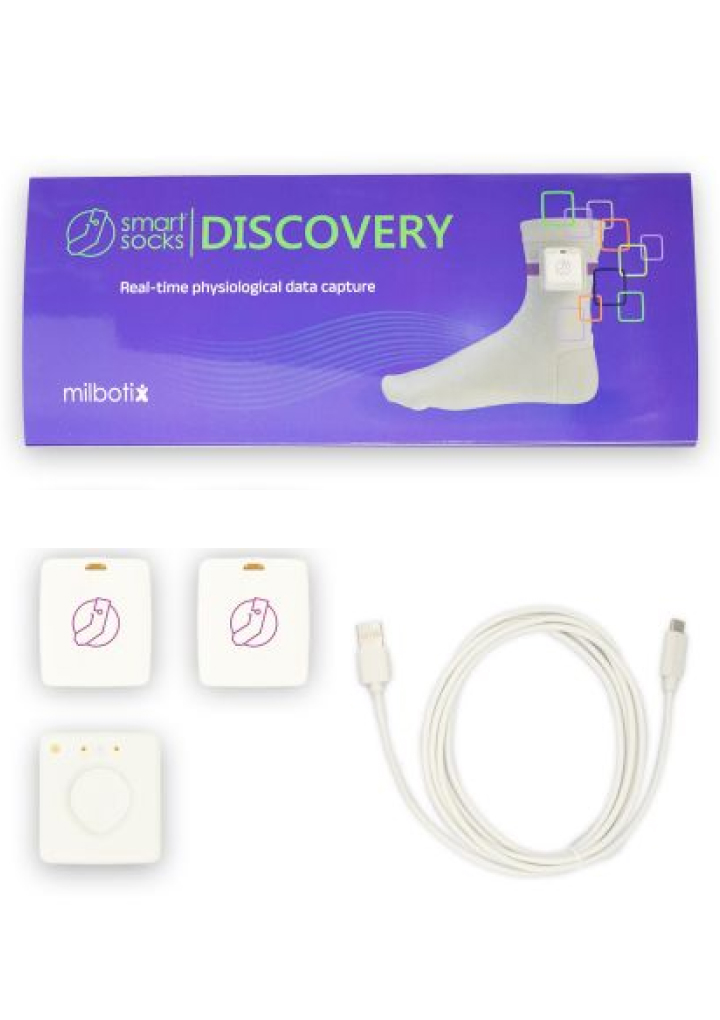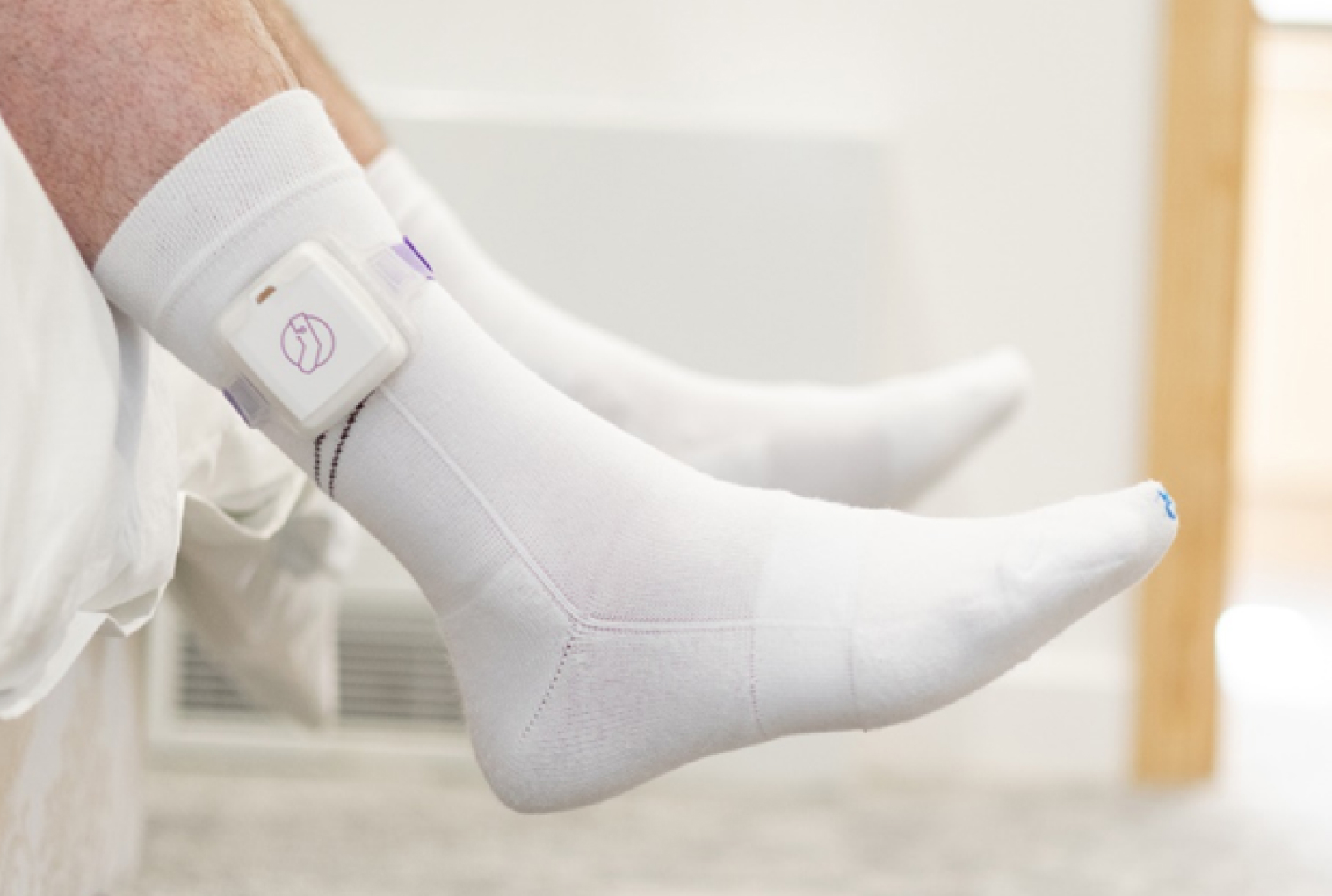Milbotix SmartSock:
Dementia wearable sensor
The brief
Milbotix approached us with a concept for a sensor that would allow caregivers to unobtrusively monitor signs of anxiety and distress — particularly in individuals who struggle to communicate. The idea is grounded in well-established data showing that emotional distress can trigger subtle physiological changes.
So why on the ankle?
Well traditional wrist-worn devices can cause irritation, are often fidgeted with or removed, and are therefore prone to being lost or damaged. Additionally, these devices often rely on complex touchscreen interfaces, which can be difficult to use for individuals with cognitive impairments.
This solution also incorporated EDA electrodes that are woven into the sock to measure skin conductivity and help inferior stress levels in users.
The bang
One of the key challenges in this project was miniaturisation. While technical constraints i.e internal electronics, meant the design couldn’t be as compact as initially hoped, we worked to keep the device as small and unobtrusive as possible. This required precision engineering using M1.4 screws, ultrasonic welding, and carefully selected adhesives.
Waterproofing added complexity. To avoid unsustainable options like epoxy potting, we chose ultrasonic welding. This ensured a strong seal while allowing end-of-life disassembly. Although it limited repairability, it offered the most balanced and responsible trade-off.
Thermal management was another challenge. Wireless charging caused overheating, so we switched to a bespoke sprung-pin system midway through the project.
We also prioritized user comfort. To connect the sock and sensor without causing discomfort, we used a flexible TPE dock and soft conductive foam contacts, avoiding pressure points and keeping the device safe and wearable.
The result
The first-generation SmartSocks product is now in use, worn by individuals living with dementia. This milestone marks the successful transformation of a complex concept into a real-world solution — one that is already making a tangible difference in care settings.
Each SmartSock contains an embedded sensor that unobtrusively monitors physiological signals linked to the body’s fight-or-flight response. By tracking changes in sweat levels, pulse rate, pulse variability, and peripheral skin temperature, the system helps caregivers detect early signs of anxiety and distress — even when the wearer can’t communicate verbally.
Milbotix led the project with funding from Innovate UK, Cranfield University, and many others, and received invaluable support from partners like the Alzheimer’s Society. Bang proudly partnered on the project and contributed to the development of this vital product. Supporting a solution that helps manage Alzheimer’s — a devastating disease that affects so many — has been a genuine pleasure.




Milbotix SmartSock:
Dementia wearable sensor
The brief
Milbotix approached us with a concept for a sensor that would allow caregivers to unobtrusively monitor signs of anxiety and distress — particularly in individuals who struggle to communicate. The idea is grounded in well-established data showing that emotional distress can trigger subtle physiological changes.
So why on the ankle?
Well traditional wrist-worn devices can cause irritation, are often fidgeted with or removed, and are therefore prone to being lost or damaged. Additionally, these devices often rely on complex touchscreen interfaces, which can be difficult to use for individuals with cognitive impairments.
This solution also incorporated EDA electrodes that are woven into the sock to measure skin conductivity and help inferior stress levels in users.
The bang
One of the key challenges in this project was miniaturisation. While technical constraints i.e internal electronics, meant the design couldn’t be as compact as initially hoped, we worked to keep the device as small and unobtrusive as possible. This required precision engineering using M1.4 screws, ultrasonic welding, and carefully selected adhesives.
Waterproofing added complexity. To avoid unsustainable options like epoxy potting, we chose ultrasonic welding. This ensured a strong seal while allowing end-of-life disassembly. Although it limited repairability, it offered the most balanced and responsible trade-off.
Thermal management was another challenge. Wireless charging caused overheating, so we switched to a bespoke sprung-pin system midway through the project.
We also prioritized user comfort. To connect the sock and sensor without causing discomfort, we used a flexible TPE dock and soft conductive foam contacts, avoiding pressure points and keeping the device safe and wearable.
The result
The first-generation SmartSocks product is now in use, worn by individuals living with dementia. This milestone marks the successful transformation of a complex concept into a real-world solution — one that is already making a tangible difference in care settings.
Each SmartSock contains an embedded sensor that unobtrusively monitors physiological signals linked to the body’s fight-or-flight response. By tracking changes in sweat levels, pulse rate, pulse variability, and peripheral skin temperature, the system helps caregivers detect early signs of anxiety and distress — even when the wearer can’t communicate verbally.
Milbotix led the project with funding from Innovate UK, Cranfield University, and many others, and received invaluable support from partners like the Alzheimer’s Society. Bang proudly partnered on the project and contributed to the development of this vital product. Supporting a solution that helps manage Alzheimer’s — a devastating disease that affects so many — has been a genuine pleasure.
Milbotix SmartSock:
Dementia wearable sensor
The brief
Milbotix approached us with a concept for a sensor that would allow caregivers to unobtrusively monitor signs of anxiety and distress — particularly in individuals who struggle to communicate. The idea is grounded in well-established data showing that emotional distress can trigger subtle physiological changes.
So why on the ankle?
Well traditional wrist-worn devices can cause irritation, are often fidgeted with or removed, and are therefore prone to being lost or damaged. Additionally, these devices often rely on complex touchscreen interfaces, which can be difficult to use for individuals with cognitive impairments.
This solution also incorporated EDA electrodes that are woven into the sock to measure skin conductivity and help inferior stress levels in users.
The bang
One of the key challenges in this project was miniaturisation. While technical constraints i.e internal electronics, meant the design couldn’t be as compact as initially hoped, we worked to keep the device as small and unobtrusive as possible. This required precision engineering using M1.4 screws, ultrasonic welding, and carefully selected adhesives.
Waterproofing added complexity. To avoid unsustainable options like epoxy potting, we chose ultrasonic welding. This ensured a strong seal while allowing end-of-life disassembly. Although it limited repairability, it offered the most balanced and responsible trade-off.
Thermal management was another challenge. Wireless charging caused overheating, so we switched to a bespoke sprung-pin system midway through the project.
We also prioritized user comfort. To connect the sock and sensor without causing discomfort, we used a flexible TPE dock and soft conductive foam contacts, avoiding pressure points and keeping the device safe and wearable.
The result
The first-generation SmartSocks product is now in use, worn by individuals living with dementia. This milestone marks the successful transformation of a complex concept into a real-world solution — one that is already making a tangible difference in care settings.
Each SmartSock contains an embedded sensor that unobtrusively monitors physiological signals linked to the body’s fight-or-flight response. By tracking changes in sweat levels, pulse rate, pulse variability, and peripheral skin temperature, the system helps caregivers detect early signs of anxiety and distress — even when the wearer can’t communicate verbally.
Milbotix led the project with funding from Innovate UK, Cranfield University, and many others, and received invaluable support from partners like the Alzheimer’s Society. Bang proudly partnered on the project and contributed to the development of this vital product. Supporting a solution that helps manage Alzheimer’s — a devastating disease that affects so many — has been a genuine pleasure.





